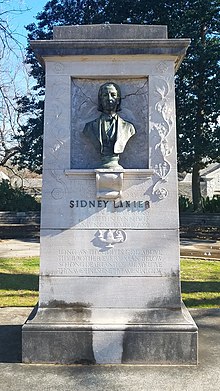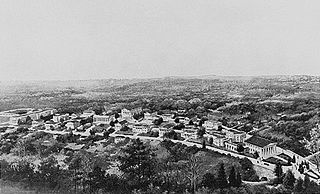
DeKalb County is located in the north central portion of the U.S. state of Georgia. As of the 2020 census, the population was 764,382, making it Georgia's fourth-most populous county. Its county seat is Decatur.

Sidney Clopton Lanier was an American musician, poet and author. He served in the Confederate States Army as a private, worked on a blockade-running ship for which he was imprisoned, taught, worked at a hotel where he gave musical performances, was a church organist, and worked as a lawyer. As a poet he sometimes used dialects. Many of his poems are written in heightened, but often archaic, American English. He became a flautist and sold poems to publications. He eventually became a professor of literature at Johns Hopkins University in Baltimore, and is known for his adaptation of musical meter to poetry. Many schools, other structures and two lakes are named for him, and he became hailed in the South as the "poet of the Confederacy". A 1972 US postage stamp honored him as an "American poet".

Stone Mountain is a quartz monzonite dome monadnock and the site of Stone Mountain Park, 16 miles (26 km) east of Atlanta, Georgia. Outside the park is the small city of Stone Mountain, Georgia. The park is the most visited tourist site in the state of Georgia.
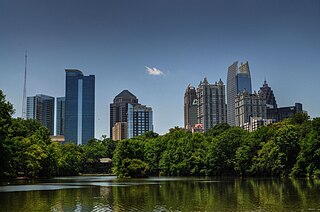
Piedmont Park is an urban park in Atlanta, Georgia, located about 1 mile (1.6 km) northeast of Downtown, between the Midtown and Virginia Highland neighborhoods. Originally the land was owned by Dr. Benjamin Walker, who used it as his out-of-town gentleman's farm and residence. He sold the land in 1887 to the Gentlemen's Driving Club, who wanted to establish an exclusive club and racing ground for horse enthusiasts. The Driving Club entered an agreement with the Piedmont Exposition Company, headed by prominent Atlantan Charles A. Collier, to use the land for fairs and expositions and later gave the park its name.

Allen George Newman III was an American sculptor, best known for his statue "The Hiker".

The Millennium Gate Museum is a triumphal arch and Georgia history museum located in Atlanta, on 17th Street in the Atlantic Station district of Midtown. The monument celebrates peaceful accomplishment. The design was a collaboration of Rodney Mims Cook Jr and Hugh Petter of ADAM Architecture to refine the 10 winning entries from a design in competition in 2000 The ten winners are: Daniel Parolek, Silva Neri

Free Nelson Mandela is a sculpture in Atlanta, Georgia, USA, created by David Hammons in 1987. Alternatively referred to as a monument, the piece was originally created as a statement demanding the liberation of the imprisoned South African activist, Nelson Mandela. The official title is Nelson Mandela Must Be Free to Lead His People and South Africa to Peace and Prosperity. However, it is most frequently called just Free Nelson Mandela, because those words are carved in the face of the granite rock that is the bottom portion of the sculpture.

The Four Southern Poets Monument, also known as the Monument to Southern Poets and Poets' Monument, is a granite monument in Augusta, Georgia, in the United States.

The Erskine Memorial Fountain is a public fountain in Grant Park of Atlanta, Georgia, United States. Designed by J. Massey Rhind in honor of John Erskine, it was the first public fountain in Atlanta. The fountain was built in 1896 and moved to its current location in 1912.

The Civil War Memorial in Savannah, Georgia, is a monument honoring soldiers who died during the American Civil War. Located in Forsyth Park, it consists of a 48 foot (15 m) tall shaft topped with a bronze statue of a Confederate soldier. Two bronze busts commemorating notable Confederate army officers flank the monument, which is protected by a railing, one of the only two that still stand around a monument, the other being the Casimir Pulaski Monument in Monterey Square. Originally known as the Confederate Monument, it was dedicated in 1875 to honor Confederate soldiers who died during the Civil War. Following the Unite the Right rally, the city of Savannah renamed and rededicated the structure in 2018. The monument is one of the oldest and largest Confederate monuments in Georgia.
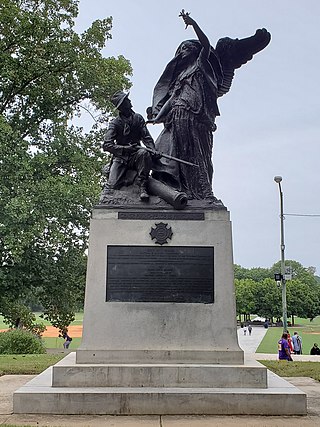
The Peace Monument is a public monument in Atlanta, Georgia, United States. Designed by Allen George Newman, the monument is located in Piedmont Park and was erected in 1911 by members of the Old Guard of the Gate City Guard, a Confederate-era militia, as a show of national unity in the years following the American Civil War. The monument has been the subject of controversy recently, with some calling for its removal as a symbol of the Lost Cause of the Confederacy.

Pioneer Women is a memorial in Atlanta, Georgia, United States. Located in Piedmont Park, the memorial, designed by Steffen Thomas, was dedicated in 1938 by the Atlanta Pioneer Women's Society to honor former members of the group.

The Confederate Obelisk is a large Confederate monument located in the Oakland Cemetery of Atlanta, Georgia, United States. The structure, a tall obelisk located in the cemetery's Confederate section, was dedicated in 1874. Due to its connection to the Confederate States of America, the monument has been vandalized repeatedly.
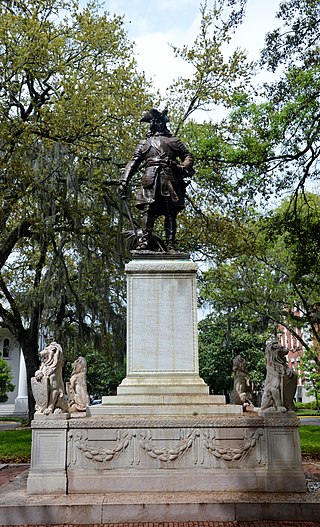
The James Oglethorpe Monument is a public monument in Chippewa Square, Savannah, Georgia, United States. The monument honors James Oglethorpe, the founder of the Province of Georgia, who established the city of Savannah in 1733. Efforts towards the monument's erection began in 1901 and were led by members of several patriotic groups in the city, who secured government funding for the monument. The monument consists of a bronze statue of Oglethorpe, designed by Daniel Chester French, atop a large granite pedestal designed by Henry Bacon. It was dedicated in 1910, in a ceremony that attracted several thousand spectators and was attended by several notable government officials.

Pershing Point Park, also known as Pershing Point Memorial Park, is a small public park in Atlanta, Georgia, United States. The park, located in midtown Atlanta, is formed by the intersection of Peachtree Street and West Peachtree Street. It was dedicated in the 1920s in honor of General of the Armies John J. Pershing and includes a memorial to Fulton County soldiers who died in World War I. The World Athletes Monument is also located in the park. A 2018 article in The Atlanta Journal-Constitution listed the park as one of three World War I memorials in the Atlanta metropolitan area.
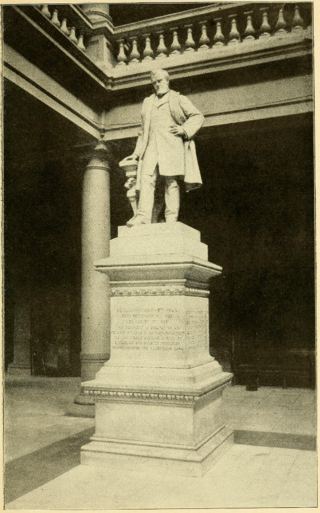
A statue of Benjamin Harvey Hill stands inside the Georgia State Capitol in Atlanta, Georgia, United States. The monumental statue was designed by American sculptor Alexander Doyle and originally dedicated in 1886 at what is now Hardy Ivy Park. The statue was relocated to the capitol building in 1890.

The Illinois Monument is a public monument located in the Kennesaw Mountain National Battlefield Park in Cobb County, Georgia, United States. The monument honors the soldiers from Illinois who fought in the Battle of Kennesaw Mountain during the Atlanta campaign of the American Civil War. It is located on Cheatham Hill, the site of intense fighting during the battle, and was dedicated in 1914, on the 50th anniversary of the battle. It was designed by Mario Korbel and James Dibelka.
